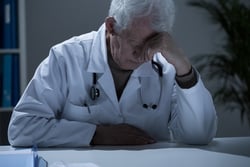 Drowsy Driving Prevention Week is November 6 through November 13.
Drowsy Driving Prevention Week is November 6 through November 13.
It falls after this weekend, when most Americans perform the mandated clock change to mark the end of Daylight Savings Time (DST).
At 2:00am on Sunday November 6, clocks "fall back" or are turned back by 1 hour to return to Standard Time.
There are plenty of discussions about the historical origins of this practice, and others which debate the value of this twice-annual time shift when it comes to school schedules and business planning. Indeed, there's a growing movement to end Daylight Savings Time altogether.
However, the focus on the time change might be better spent understanding how the shift of even one hour of sleep can seriously impact our health and well being.
Although it may seem like a bonus during the fall to "gain" an extra hour—usually celebrated as a way to catch up on lost sleep—the circadian disruption that results from a single hour's gain of sleep has consequences we need to take into consideration.
When our circadian rhythms are disrupted, one of the side effects, at least temporarily, can be sleep deprivation. Sunday morning may bring an added hour of sleep, but the time shift will make "rise and shine" on Monday morning much harder; the brain and body still need a few days to fully "reset."
One of the biggest problems linked to sleep deprivation is—you guessed it—drowsy driving. It can happen to anyone who works odd hours, overnight shifts, or who works in a job that disrupts their circadian rhythms or causes sleep loss. This includes healthcare professionals of all kinds.
WHAT IS DROWSY  DRIVING?
DRIVING?
Drowsy driving is a well-known and potentially dangerous consequence of sleep deprivation. Operating a vehicle when drowsy can lead to death, injury, and property damage.
Studies confirm drowsy driving to be a national public health and safety issue. The National Highway Traffic Safety Administration (NHTSA) estimates that annually, driver fatigue results in at least 100,000 vehicle accidents, 1500 deaths, 71,000 injuries, and $12.5 billion in economic losses.
Eleven million drivers have either crashed or nearly crashed due to drowsy driving, according to the most recent Sleep in America poll conducted by the National Sleep Foundation, which focused their inquiry on driver fatigue.
Sleep deprived people are incapable of recognizing their inherent fatigue and frequently fail to acknowledge the risks they assume when getting behind the wheel.
“Powering through” the commute home by rolling down car windows or turning up the radio won’t prevent the body’s sleep drive from kicking in. Why not? Sleep loss causes impaired brain function:
-
slower reaction times
-
impaired risk assessment
-
inattention to road signs or roadway activity
-
sluggish information processing
-
ineffective eye-hand coordination
Further, fatigued drivers are shown to experience “microsleeps”: brief sleep episodes lasting less than a second, when the brain literally switches from Wake to Sleep mode while the body remains in motion. Even so, you don't have to fall asleep to be a drowsy driver; being fatigued is symptomatic enough to qualify.
 Sleep deprivation is the confirmed cause behind many plane and bus crashes, as well as the notorious Exxon Valdez oil spill, which was not due to alcohol use, but caused by sleep deprived sailors whose actions mimicked impairments resembling those caused by drinking.
Sleep deprivation is the confirmed cause behind many plane and bus crashes, as well as the notorious Exxon Valdez oil spill, which was not due to alcohol use, but caused by sleep deprived sailors whose actions mimicked impairments resembling those caused by drinking.
In fact, the state of New Jersey passed Maggie’s Law in 2003 to criminalize drowsy driving due to the stunning similarities it shares with driving while impaired by drugs or alcohol. Other states are considering similar legislation.
WHO’S AT RISK FOR DROWSY DRIVING?
Driver fatigue directly influences the medical profession in multiple ways. It shows up:
-
In emergency departments, when fatigue-related car collisions lead to injuries (or deaths)
-
At medical practices, while treating the drowsy driving-related injuries of drivers and victims
-
In hospitalized patients who may be sleepy at discharge because of sleep lost to noisy conditions or sedating medications
-
Among healthcare workers who suffer from shift work disorder and cannot maintain adequate sleep to compensate for their sleep deprivation
 We count on caffeine to keep us awake, though new research released last June at the Denver SLEEP meeting reveals that caffeine loses its stimulating qualities after only three nights of impaired or lost sleep.
We count on caffeine to keep us awake, though new research released last June at the Denver SLEEP meeting reveals that caffeine loses its stimulating qualities after only three nights of impaired or lost sleep.
"The data from this study suggests that the same effective daily dose of caffeine is not sufficient to prevent performance decline over multiple days of restricted sleep," said study author Tracy Jill Doty of Walter Reed Army Institute of Research.
Shift workers play critical roles in our healthcare communities: nurses, paramedics, on-call physicians, technicians. Studies show that, just like commercial long-haul truck drivers, they are far more likely to fall asleep at the wheel than their 9-to-5 cohorts.
What do truckers and healthcare workers have in common? A reliance on caffeine to compensate for lost sleep.
HOW TO REDUCE THE RISK OF DROWSY DRIVING
 Patients
Patients
If you notice that a patient who has been taking sedating medications (or has used sleep aids the night before) will soon be released from your care, it’s a good practice to ensure they have a ride home with a loved one.
Barring that, you can call them a cab to make sure they return home safely.
It can be very difficult for some patients to know how they might respond to certain medications they haven't taken before. Observe their actions while in their presence: if they seem fatigued or sleepy in any way (yawning, tired eyes, slow physical responses), help them find a way home.
Co-workers
If you notice a cowor ker is having trouble focusing, yawning excessively, or otherwise struggling to stay awake, consider helping them to a private area in your workspace where they can nap for 15-20 minutes before driving home.
ker is having trouble focusing, yawning excessively, or otherwise struggling to stay awake, consider helping them to a private area in your workspace where they can nap for 15-20 minutes before driving home.
Encourage them to consume their favorite form of caffeine, and make sure they wait 30 minutes afterward for the caffeine to take effect.
Sometimes, a quickly consumed cup of coffee, followed by a short nap (popularly known as a "caffeine nap") can do the trick.
You can also offer to drive a coworker home if you share their schedule: together you can keep each other alert and reduce your accident risk. Or, have your coworker call a friend or family member for a lift; if they resist, call them a cab.
Yourself
The same rules apply. If you are rubbing your eyes and yawning, it’s a sure sign you need a nap or some caffeine before heading home, at minimum.
 If you’re already on your way home and feel yourself nodding off, there’s no shame in pulling over safely to take a cat nap. Don’t second guess your instinct to rest!
If you’re already on your way home and feel yourself nodding off, there’s no shame in pulling over safely to take a cat nap. Don’t second guess your instinct to rest!
If this becomes an ongoing problem, you can look for a rideshare to avoid the problem entirely. You might also look into medications prescribed for people suffering from shift work disorder, such as modafinil (generic name, Provigil).
Ultimately, the best prevention against driver fatigue is to sleep! Seven to nine hours of good sleep between shifts will help you adequately maintain alertness while on the job as well as during the ride home.
Keep this in mind during the next few days of the fall time change. Your circadian rhythms need to adjust to new light and new rhythms, and you don't want to drive drowsy as a result.
Sources:
Drowsy Driving.org
LiveScience
National Highway Traffic Safety Administration
National Sleep Foundation
Walter Reed Army Institute of Research


